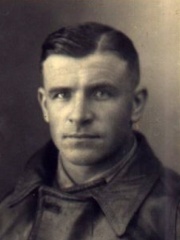
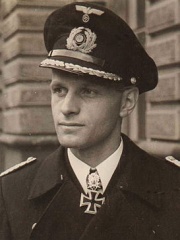
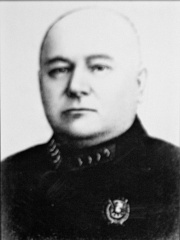
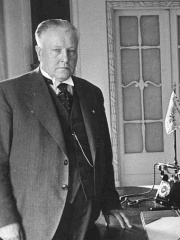
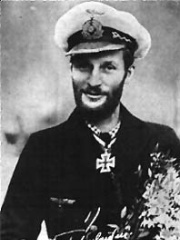
The Most Famous
MILITARY PERSONNELS from Latvia
This page contains a list of the greatest Latvian Military Personnels. The pantheon dataset contains 2,058 Military Personnels, 6 of which were born in Latvia. This makes Latvia the birth place of the 41st most number of Military Personnels behind Kazakhstan, and Slovakia.
Top 6
The following people are considered by Pantheon to be the most legendary Latvian Military Personnels of all time. This list of famous Latvian Military Personnels is sorted by HPI (Historical Popularity Index), a metric that aggregates information on a biography's online popularity.

1. Herberts Cukurs (1900 - 1965)
With an HPI of 67.14, Herberts Cukurs is the most famous Latvian Military Personnel. His biography has been translated into 27 different languages on wikipedia.
Herberts Albert Cukurs (17 May 1900 – 23 February 1965) was a Latvian aviator and Nazi collaborator. He served as the deputy commander of the Arajs Kommando, a collaborationist unit that carried out the largest mass murders of Latvian Jews during the Holocaust. Although Cukurs never stood trial, the accounts of multiple Holocaust survivors, including Zelma Shepshelovitz, credibly link him to personally supervising and committing war crimes and crimes against humanity for the duration of the German occupation of Latvia. His crimes included shooting Jewish children and babies in captivity, burning Jews alive, and sexually assaulting Jewish women. Two decades after World War II, Cukurs was identified in Brazil by a Holocaust survivor, who attempted to alert the authorities after seeing Cukurs' face on the cover of a magazine. Following the discovery, Cukurs was investigated and, in 1965, assassinated in Shangrilá, Uruguay by Nazi hunters who were working for Mossad, the national intelligence agency of Israel. In the aftermath of the assassination, Israeli journalist Gad Shimron and one of the Mossad agents ("Künzle") who killed Cukurs authored a book on the experience, titled The Execution of the Hangman of Riga. In it, they referred to Cukurs as the Butcher of Latvia, a name later used by several other sources. One of the main goals of Cukurs's assassination was to pressure West Germany into extending the statute of limitations on Nazi war crimes. In 1964, the West German government announced that it would allow the statute of limitations to expire in 1965. Following Cukurs's assassination, however, the deadline was extended to 1969 and then to 1979, before the statute of limitations on murder was finally abolished entirely.

2. Wolfgang Lüth (1913 - 1945)
With an HPI of 64.06, Wolfgang Lüth is the 2nd most famous Latvian Military Personnel. His biography has been translated into 21 different languages.
Wolfgang Lüth (15 October 1913 – 14 May 1945) was a German U-boat captain of World War II who was credited with the sinking of 46 merchant ships plus the French submarine Doris sunk during 15 war patrols, for a total tonnage of 225,204 gross register tons (GRT). Lüth joined the Reichsmarine in 1933. After a period of training on surface vessels, he transferred to the U-boat service in 1936. In December 1939 he received command of U-9, which he took on six war-patrols. In June 1940 he took command of U-138 for two patrols. In October 1940 he transferred again, this time to the ocean-going submarine U-43 for five war-patrols. After two patrols on U-181, the second being his longest of the war, he was awarded the Knight's Cross of the Iron Cross with Oak Leaves, Swords and Diamonds. He was the first of two U-boat commanders to be so honored during World War II, the other recipient being Albrecht Brandi. Lüth's last service position was commander of the Naval Academy Mürwik near Flensburg. He was accidentally shot and killed by a German sentry after the end of the war on the night of 13/14 May 1945. On 16 May 1945, Lüth was given a state funeral by the Flensburg Government.

3. Jukums Vācietis (1873 - 1938)
With an HPI of 63.04, Jukums Vācietis is the 3rd most famous Latvian Military Personnel. His biography has been translated into 24 different languages.
Jukums Vācietis (Russian: Иоаким Иоакимович Вацетис, romanized: Ioakim Ioakimovich Vatsetis; 23 November [O.S. 11 November] 1873 – 28 July 1938) was a Latvian and Soviet military commander. He was a rare example of a notable Soviet leader who was not a member of the Communist Party (or of any other political party), until his demise during the Great Purge in the 1930s.

4. Jānis Balodis (1881 - 1965)
With an HPI of 59.97, Jānis Balodis is the 4th most famous Latvian Military Personnel. His biography has been translated into 20 different languages.
Jānis Balodis (20 February 1881 – 8 August 1965) was an army general, Commander-in-Chief of the Armed Forces of Latvia (1919–1921), Minister of War (1931–1940), and a politician who was one of the principal figures during the Latvian War of Independence and the dictatorship of Kārlis Ulmanis, when he was officially the number two of the regime as the Minister of War, Deputy Prime Minister and Vice President.
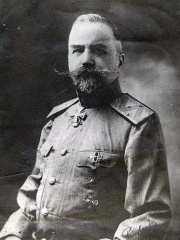
5. Yevgeny Miller (1867 - 1939)
With an HPI of 59.84, Yevgeny Miller is the 5th most famous Latvian Military Personnel. Her biography has been translated into 21 different languages.
Yevgeny-Ludvig Karlovich Miller (Russian: Евге́ний-Лю́двиг Ка́рлович Ми́ллер; 7 October [O.S. 25 September] 1867 – 11 May 1939) was a Russian general of Baltic German descent and one of the leaders of the anti-communist White Army during the Russian Civil War. After the civil war, he lived in exile in France. Kidnapped by Soviet intelligence operatives in Paris in 1937, he was smuggled to the Soviet Union and executed in Moscow in 1939.

6. Hans-Diedrich von Tiesenhausen (1913 - 2000)
With an HPI of 57.63, Hans-Diedrich von Tiesenhausen is the 6th most famous Latvian Military Personnel. His biography has been translated into 15 different languages.
Hans-Diedrich von Tiesenhausen (22 February 1913 – 17 August 2000) was a German naval commander during World War II. He was a recipient of the Knight's Cross of the Iron Cross of Nazi Germany.
People
Pantheon has 6 people classified as Latvian military personnels born between 1867 and 1913. Of these 6, none of them are still alive today. The most famous deceased Latvian military personnels include Herberts Cukurs, Wolfgang Lüth, and Jukums Vācietis.
Deceased Latvian Military Personnels
Go to all RankingsHerberts Cukurs
1900 - 1965
HPI: 67.14
Wolfgang Lüth
1913 - 1945
HPI: 64.06
Jukums Vācietis
1873 - 1938
HPI: 63.04
Jānis Balodis
1881 - 1965
HPI: 59.97
Yevgeny Miller
1867 - 1939
HPI: 59.84
Hans-Diedrich von Tiesenhausen
1913 - 2000
HPI: 57.63
Overlapping Lives
Which Military Personnels were alive at the same time? This visualization shows the lifespans of the 6 most globally memorable Military Personnels since 1700.

